

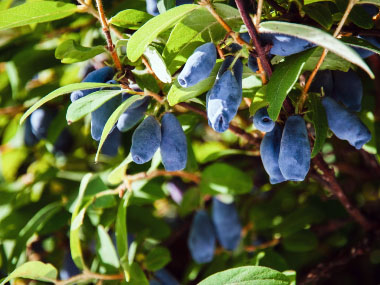
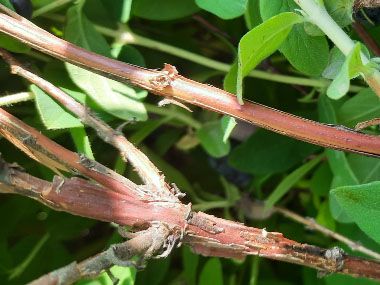
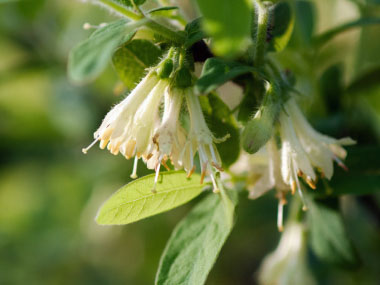
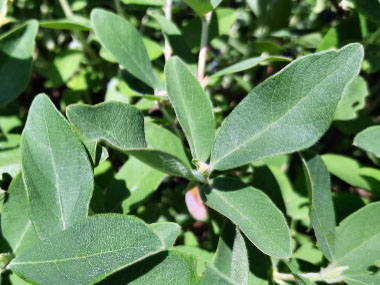
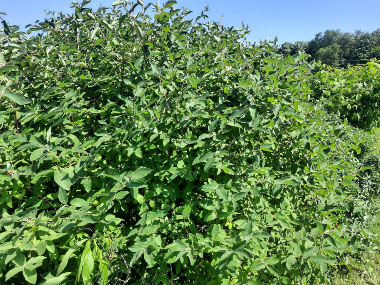
To support our efforts please browse our store (books with medicinal info, etc.).
For centuries, haskap berries have been popular in Japan; in fact, the word 'haskap' is Japanese for “berry of long life and good vision.” Also known as honeyberries, blue honeysuckle, and fly honeysuckle, this shrub has become popular to grow in gardens. Native to Asia and Europe, this shrub, once in bloom, is frost tolerant. The genus name was given to this shrub due to Adam Lonitzer (1528-1586), a German botanist. The epithet caerulea means "dark blue" which in reference to the fruit color. In order for this shrub to produce berries, a male and female shrub is required. According to haskap.ca, the berries have an extremely high ORAC value, and they have high levels of anthocyanins, polyphenols and bioflavanoids.
Trunk/Bark
The main trunk can get thick; thickness varies on the age of the shrub. The outer bark splits and looks almost like an old riverbank grape vine. (Looks like shredded bark.)
Branches/Twigs
This is a multi-branched deciduous shrub. Light to pale brown branches. Newer branches are smooth, older branches are rough.
Height
These shrubs can grow up to 2 metres (6') high and can be just as wide.
Leaves/Needles
Leaves grow opposite, are elliptic to ovate, dull greyish-green leaves that measure anywhere from 5 to 7cm (2 to 3” long). Some of the leaves have a slightly wavy margins.
Flowers
Pale yellowish-white flowers measure 1.5cm (5/8” long) and tends to bloom in late spring. They occur in pairs along the shoots. The flowers can take up to a -7 to -11C (12 to 19F) frost.
Fruit
Small oblong fruits ripen in early summer and are a deep blue on the outside and reddish-purple inside. Seeds aren’t noticeable when eating as they are very small. The fruit grows mostly under the foliage, and it can be difficult to know when they are ready to be picked. Cedar Waxwing birds love these berries so if you see them coming out of the bush, you know they are ready.
Habitat
The haskaps are often found in the wild on the edge of wetlands, swamps, and in mountainous regions. Haskaps like full sun but can be found in part sun locations. They are known to grow across Canada, and as far north as Alaska. They also have been spotted in the northeast U.S. as well as the northwest U.S.
Edible Parts
The berries are edible. They are a pleasant taste that is similar to blueberry with a very slight tartness. They can be enjoyed as is, in smoothies, baking, syrups, juice and made into wine. This fruit is high in antioxidants, some reports state they have more antioxidants than blueberries. They are also rich with the B-vitamins and vitamin C.
Other Name
Fly Honeysuckle.
Winter Survival Food Handbook

PDF Plant Magazines
Types of Wild Food
Geographic Zones Seasons
Disclaimer
EdibleWildFood.com is informational in nature. While we strive to be 100% accurate, it is solely up to the reader to ensure proper plant identification. Some wild plants are poisonous or can have serious adverse health effects.
We are not health professionals, medical doctors, nor are we nutritionists. It is up to the reader to verify nutritional information and health benefits with qualified professionals for all edible plants listed in this web site. Please click here for more information.
Why Edible Wild Food?
- Food costs are rising
- Free, wild food is readily abundant
- Wild food adds nutrition to your diet
- Wild food can help treat various medical conditions





